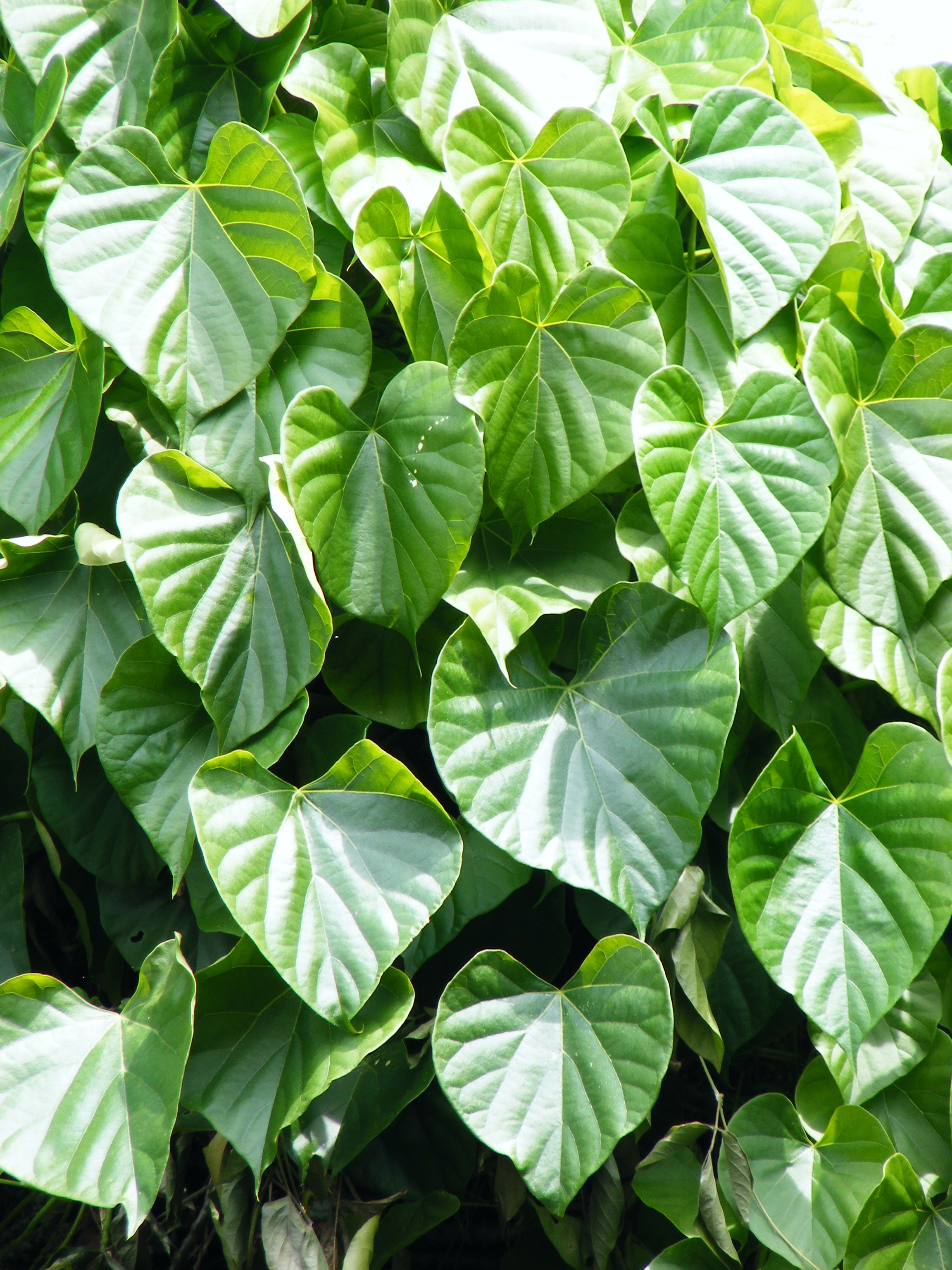- Tinospora cordifolia
Taxobox
name = "Tinospora cordifolia"

regnum =Plant ae
divisio = Magnoliophyta
classis =Magnoliopsida
ordo =Ranunculales
familia =Menispermaceae
genus = "Tinospora "
species = "T. cordifolia"
binomial = "Tinospora cordifolia"
binomial_authority = (Thunb. ) Miers"Tinospora cordifolia", also called Guduchi is an
herbaceous vine of the familyMenispermaceae indigenous to the tropical areas ofIndia ,Myanmar andSri Lanka .Synonyms: Guduchi , amrita (Sanskrit), giloe , gulancha (Bengali), giloya (Hindi), gado , galo (Gujarati), duyutige , teppatige (Telugu), heartleaf moonseed (English)
According to the 1911 British Pharmaceutical Codex, "Tinospora or Gulancha consists of the dried stem of Tinospora cordifolia, Miers (N.O. Menispermaceae), a climbing shrub indigenous to tropical India. The stems are collected in the hot season and dried. The drug occurs in straight or twisted cylindrical pieces and in slices, averaging about 2 centimetres in diameter, some pieces being much smaller. Externally, they are covered with a thin, papery, brown cork, bearing the raised scars of numerous
lenticels . The cork readily exfoliates and discloses a greenish cortex longitudinally wrinkled and marked with lenticels. The fracture is fibrous and the transverse section exhibits a yellowish wood with radially arranged wedge-shaped wood bundles, containing large vessels, separated by narrower medullary rays. The odour is not characteristic, but the taste is bitter." [ [http://www.henriettesherbal.com/eclectic/bpc1911/tinospora.html Tinospora, I.C.A. Tinospora. | Henriette's Herbal Homepage] ]Constituents
The active
adaptogen ic constituents are diterpene compounds including tinosporone, tinosporic acid, cordifolisides A to E, syringen, the yellow alkaloid,berberine , Giloin, crude Giloininand, a glucosidal bitter principle as well as polysaccharides, including arabinogalactan polysaccharide (TSP). [Winston, David & Maimes, Steven. “Adaptogens: Herbs for Strength, Stamina, and Stress Relief,” Healing Arts Press, 2007.][ [http://medind.nic.in/ibi/t03/i2/ibit03i2p83.pdf] S.S. SINGH, S.C. PANDEY, S. SRIVASTAVA, V.S. GUPTA, B. PATRO, A.C. GHOSHCHEMISTRY AND MEDICINAL PROPERTIES OF TINOSPORA CORDIFOLIA (GUDUCHI)Indian Journal of Pharmacology 2003; 35: 83-91]
Ethnobotanical Uses
According to the 1918 United States Dispensatory edited by Joseph Remington, Horatio Wood et al.:
Tinospora. Br. Add. 1900.—"The dried stem of Tinospora cordifolia Miers (Fam. Menispermaceae), collected in the hot season." Br. Add., 1900. Tinospora has long been used in India as a medicine and in the preparation of a starch known as gilae-ka-sat or as palo. It is said to be a tonic, antiperiodic, and a diuretic. Flückiger obtained from it traces of an alkaloid and a bitter glucoside. The Br. Add., 1900, recognized an infusion (Infusum Tinosporae Br. Add., 1900, two ounces to the pint), dose one-half to one fluidounce (15-30 mils); a tincture (Tinctura Tinosporae Br. Add., 1900, four ounces to the pint), dose, one-half to one fluidrachm (1.8-3.75 mils); and a concentrated solution [Liquor Tinosporae Concentratus Br. Add., 1900), dose, one-half to one fluidrachm (1.8-3.75 mils).
Tinospora crispa Miers (more), which is abundant in thePhilippines , is used freely by the natives under the name of makabuhay (that is, "You may live"), as a panacea, especially valuable in general debility, in chronic rheumatism, and in malarial fevers. It may be prepared in the same way and given in the same doses as Tinospora cordifolia. [ [http://www.henriettesherbal.com/eclectic/usdisp/tinospora.html Tinospora. Tinospora cordifolia. | Henriette's Herbal Homepage ] ]Modern use in herbal medicine
"Tinospora cordifolia" is used in
Ayurvedic herbal medicine as a hepatoprotectant, protecting theliver from damage that may occur following exposure to toxins. Recent research has demonstrated that a combination of "T. cordifolia" extract andturmeric extract is effective in preventing the hepatotoxicity which is otherwise produced as a side effect of conventional pharmaceutical treatments fortuberculosis using drugs such asisoniazid andrifampicin . [Adhvaryu MR, Reddy MN, Vakharia BC. Prevention of hepatotoxicity due to anti tuberculosis treatment: A novel integrative approach. "World Journal of Gastroenterology" 2008; 14(30): 4753-4762.]References
Wikimedia Foundation. 2010.
